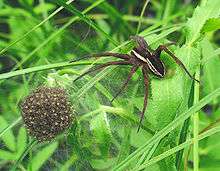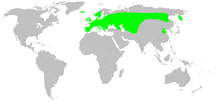Raft spider
| Raft spider | |
|---|---|
_female.jpg) | |
| Female with egg sac | |
 | |
| Female with juvenile spiders | |
| Scientific classification | |
| Kingdom: | Animalia |
| Phylum: | Arthropoda |
| Subphylum: | Chelicerata |
| Class: | Arachnida |
| Order: | Araneae |
| Infraorder: | Araneomorphae |
| Family: | Pisauridae |
| Genus: | Dolomedes |
| Species: | D. fimbriatus |
| Binomial name | |
| Dolomedes fimbriatus | |
 | |
| Synonyms[1] | |
|
Araneus fimbriatus Clerck, 1757 | |
The raft spider, scientific name Dolomedes fimbriatus, is a European spider of the family Pisauridae. The raft spider is one of the two largest spiders in the United Kingdom, and derives its name from its ability to walk on water.
Like other Dolomedes spiders it hunts by running on the surface of water, and can submerge altogether to hide from predators.
It was described in chapter 5 of the book Svenska Spindlar by the Swedish arachnologist and entomologist Carl Alexander Clerck. It is the type species of its genus.
The female's body measures up to 22 mm (7⁄8 in) long with a leg span of about 70 mm (2 3⁄4 in); as with most spiders the male is considerably smaller.
Raft spiders are semiaquatic and live around acidic bogs and in wet acidic grassland, especially where there are small pools of water. They are dark chocolate brown in colour (or sometimes greenish) with a conspicuous white or cream stripe along each side. The closely related great raft spider (Dolomedes plantarius) is similar in size, habits and appearance, but lives in fens.

References
- 1 2 "Taxon details Dolomedes fimbriatus (Clerck, 1757)", World Spider Catalog, Natural History Museum Bern, retrieved 2017-09-13
Further reading
- Arnqvist, G. (1992). "Courtship behavior and sexual cannibalism in the semi-aquatic fishing spider, Dolomedes fimbriatus (Clerck)(Araneae: Pisauridae)" (PDF). Journal of Arachnology: 222–226.
External links
| Wikispecies has information related to Raft spider |

- Raft spider at Digital Wildlife
- Raft spider photos